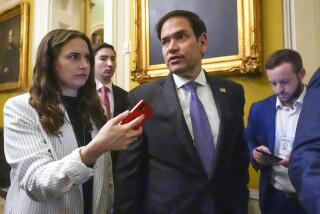Federal Use of Wiretaps Sharply Rises Under Clinton Administration
- Share via
WASHINGTON — The Clinton administration has sharply increased use of federal telephone wiretaps and other electronic surveillance in the United States since taking office, and official estimates foresee that the growth will continue in coming years.
The expansion has been driven in large part by stepped-up use of electronic eavesdropping against narcotics traffickers. In addition, a substantial rise in spending on federal law enforcement has overridden the chief constraint on use of wiretaps--their relatively high cost.
While federal electronic surveillance has been expanding for more than a decade, the trend has accelerated under the Clinton administration. Last year marked the first time federal courts approved more wiretaps than all state courts combined.
“We are up 30% to 40% this year,” said Frederick D. Hess, who runs the Justice Department office that approves applications for court-ordered wiretaps. This maintains the pace set in 1993, when the number of federal surveillance orders rose 32%.
In 1992, the last year of the Bush administration, there were 340 federal court orders permitting electronic surveillance in criminal cases. That number rose to 672 last year, officials say, and the total for 1996 almost certainly will rise above 700.
Those figures do not include “national security” wiretap orders, obtained under intelligence legislation, which also have been rising swiftly.
The acceleration of wiretapping during the Clinton administration stems in part from Atty. Gen. Janet Reno’s decision to accept recommendations of career narcotics supervisors in the Justice Department’s Criminal Division, who strongly back electronic surveillance as a particularly effective tool in the drug war.
A second growth factor is the fast buildup of federal law enforcement generally, in which hundreds of prosecutors, agents and support personnel have been added nationwide. The FBI’s budget has grown 53% since 1993, while the Drug Enforcement Administration’s budget has jumped 33%. Both agencies are asking for large budget increases in fiscal 1997.
This new funding has been a factor in making possible increased use of electronic surveillance. Federal wiretaps cost more than $70,000 a month to operate and generate hundreds of hours of labor for monitors, transcribers, surveillance teams and investigators. Larger budgets mean cost is less of an obstacle.
Building for the future, the DEA is carrying out a $33-million program to replace single-line wiretapping gear with equipment that can monitor 40 lines simultaneously and process the intercepted conversations by computer. The FBI is plowing millions of dollars into developing interception techniques for digital lines and expanding its cadre of agents who use the bureau’s high-tech surveillance gear.
More to Read
Sign up for Essential California
The most important California stories and recommendations in your inbox every morning.
You may occasionally receive promotional content from the Los Angeles Times.













